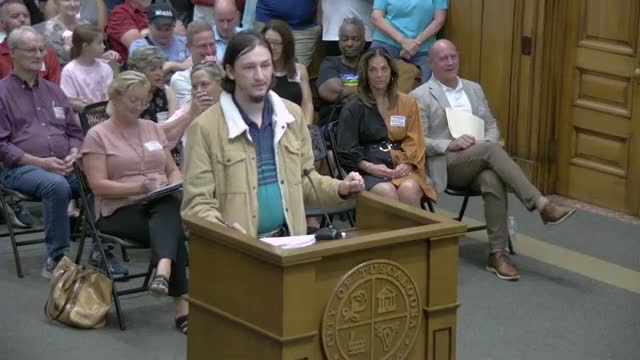Residents rally against controversial housing development proposal
August 19, 2024 | Tuscaloosa City, Tuscaloosa County, Alabama
This article was created by AI summarizing key points discussed. AI makes mistakes, so for full details and context, please refer to the video of the full meeting. Please report any errors so we can fix them. Report an error »

In a recent government meeting, significant concerns were raised regarding the proposed Dawkins Place subdivision, which aims to add 262 family lots to the Highway 69 South area. Residents from surrounding neighborhoods, particularly Waterford Place, voiced strong opposition, citing potential negative impacts on traffic, safety, and local infrastructure.
During the meeting, traffic studies were discussed, revealing that the proposed development could generate approximately 198 car trips during morning peak hours and 267 in the evening. However, residents expressed skepticism about these findings, emphasizing that existing traffic conditions on Old Greensboro Road and Highway 69 South are already problematic, particularly during school drop-off and pick-up times. Concerns were raised about the adequacy of the current road infrastructure to handle the additional traffic, with some residents suggesting that emergency response times could be adversely affected.
Opponents of the development highlighted broader implications for community safety and quality of life. Carol Armstrong, a resident of Waterford Lane, articulated fears about increased traffic accidents and the strain on local emergency services. She also pointed to potential issues with the existing sewer system, which is reportedly nearing capacity, raising alarms about health risks associated with overburdened infrastructure.
Tiffany Ezell, another resident, criticized the developer, Doctor Horton, for a perceived lack of commitment to local communities, citing past legal issues related to substandard construction practices in other states. Ezell argued that the proposed development would not only diminish property values in the area but also fail to align with the city’s long-term planning goals aimed at creating attractive and sustainable neighborhoods.
Craig Whitfield and Parrish Boland echoed these sentiments, emphasizing that the density of the proposed subdivision is inconsistent with the character of existing neighborhoods. They raised concerns about the potential for increased school overcrowding and the burden on city services, questioning the wisdom of approving such a development in an already strained area.
As the commission prepares to make a decision, the voices of local residents underscore a community deeply concerned about the implications of the Dawkins Place project, advocating for a more cautious approach to development that prioritizes the health, safety, and well-being of existing neighborhoods.
During the meeting, traffic studies were discussed, revealing that the proposed development could generate approximately 198 car trips during morning peak hours and 267 in the evening. However, residents expressed skepticism about these findings, emphasizing that existing traffic conditions on Old Greensboro Road and Highway 69 South are already problematic, particularly during school drop-off and pick-up times. Concerns were raised about the adequacy of the current road infrastructure to handle the additional traffic, with some residents suggesting that emergency response times could be adversely affected.
Opponents of the development highlighted broader implications for community safety and quality of life. Carol Armstrong, a resident of Waterford Lane, articulated fears about increased traffic accidents and the strain on local emergency services. She also pointed to potential issues with the existing sewer system, which is reportedly nearing capacity, raising alarms about health risks associated with overburdened infrastructure.
Tiffany Ezell, another resident, criticized the developer, Doctor Horton, for a perceived lack of commitment to local communities, citing past legal issues related to substandard construction practices in other states. Ezell argued that the proposed development would not only diminish property values in the area but also fail to align with the city’s long-term planning goals aimed at creating attractive and sustainable neighborhoods.
Craig Whitfield and Parrish Boland echoed these sentiments, emphasizing that the density of the proposed subdivision is inconsistent with the character of existing neighborhoods. They raised concerns about the potential for increased school overcrowding and the burden on city services, questioning the wisdom of approving such a development in an already strained area.
As the commission prepares to make a decision, the voices of local residents underscore a community deeply concerned about the implications of the Dawkins Place project, advocating for a more cautious approach to development that prioritizes the health, safety, and well-being of existing neighborhoods.
View full meeting
This article is based on a recent meeting—watch the full video and explore the complete transcript for deeper insights into the discussion.
View full meeting
